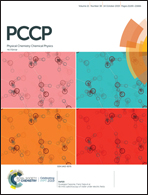A methodical study of quantum phase engineering in topological crystalline insulator SnTe and related alloys
Abstract
Topological crystalline insulators (TCIs) are particularly one of the most fascinating materials in current research. The gapless surface states protected by the crystal point group symmetries in TCIs entail the emergence of nontrivial physics and can be tailored by controlling the external perturbations. This paper is devoted to a detailed analysis of the perturbation effects on the quantum phase of SnTe(001) surface states. Generically, surface states are gradually perturbed so that the gapless phase dies out. In doing so, a numerical study of the perturbed ![[k with combining right harpoon above (vector)]](https://www.rsc.org/images/entities/i_char_006b_20d1.gif) ·
·![[p with combining right harpoon above (vector)]](https://www.rsc.org/images/entities/i_char_0070_20d1.gif) model is accomplished by the linear response theory and the Green's function technique. The model is experimentally accessible. The system displays a commensurate breaking of the mirror invariance imposed by external perturbations such as strain, magnetic proximity effect/electric field/Zeeman magnetic field, Rashba spin–orbit coupling, and dilute charged impurity. The interesting behaviors are explained by the variation of the gap with the above-mentioned perturbations (invoking the opening of the gap) at Dirac cones corresponding to the TCI phase. For suitably tuned parameters, SnTe(001) surface states realize gapped phases. The synergy of perturbations is responsible for breaking down the topologically non-trivial character of SnTe and related alloys. Further, the conditions under which the variations of the parameters maintain the topological properties are discussed. These findings and predictions report that, besides a vast number of TCI applications, TCIs are versatile candidates for topological transistors with tunable ON and OFF states if appropriate tuning of the surface band gap can be performed experimentally.
model is accomplished by the linear response theory and the Green's function technique. The model is experimentally accessible. The system displays a commensurate breaking of the mirror invariance imposed by external perturbations such as strain, magnetic proximity effect/electric field/Zeeman magnetic field, Rashba spin–orbit coupling, and dilute charged impurity. The interesting behaviors are explained by the variation of the gap with the above-mentioned perturbations (invoking the opening of the gap) at Dirac cones corresponding to the TCI phase. For suitably tuned parameters, SnTe(001) surface states realize gapped phases. The synergy of perturbations is responsible for breaking down the topologically non-trivial character of SnTe and related alloys. Further, the conditions under which the variations of the parameters maintain the topological properties are discussed. These findings and predictions report that, besides a vast number of TCI applications, TCIs are versatile candidates for topological transistors with tunable ON and OFF states if appropriate tuning of the surface band gap can be performed experimentally.



 Please wait while we load your content...
Please wait while we load your content...